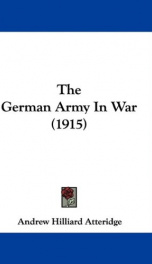the german army in war

Purchase of this book includes free trial access to www.million-books.com where you can read more than a million books for free. This is an OCR edition with typos. Excerpt from book: CHAPTER II DEVELOPMENT OF THE ARMY SYSTEM AT the close of the Napoleonic Wars the population of the lands now included in the German Empire was about 25,000,000. When the empire was proclaimed in 1871, the population was in round numbers 40,000,000. The last census of the empire taken on December 1st, 1910, gave a grand total of 64,925,993, so that the German empire has now a population of about 68,000,000. It is estimated that in any given year the men reaching the age of twenty, and thus becoming liable to military service, are about one per cent, of the population. Thus, while in 1871, at the close of the war with France, there would be about 400,000 young men liable to service in that year, the number in any year since 1910 would be 650,000. In forty years the growth of the population has thus increased the available number of recruits by a quarter of a million. It has already been noted that the Wehrpflicht (duty of defence), as the Germans call the universalliability to military service, does not mean that every man liable to serve is actually embodied in the army. Each year the Ministry of War and the General Staff fix the number of recruits to be called up. In these estimates an allowance is made for men not up to the physical standard or otherwise disqualified for the army. See note in Introduction on the number of men available for military service. In Germany, as in all countries where universal liability to service exists, careful registers are kept of the men in every town and district. One cannot remove from one place to another, or even change one's place of residence in the same town without giving immediate notice to the police. In the year in which his twentieth birthday occurs, a young man must present himself at a recruiting depot, as otherwise he ... --This text refers to the Paperback edition.
Info about the book
Series:
Unknown
ISBN:
1849086478
Rating:
5/5 (4)Your rating:
0/5
Languge:
English
Users who have this book
Users who want this book
What readers are saying
What do you think? Write your own comment on this book!
write a commentif you like the german army in war try:
Do you want to read a book that interests you? It’s EASY!
Create an account and send a request for reading to other users on the Webpage of the book!




